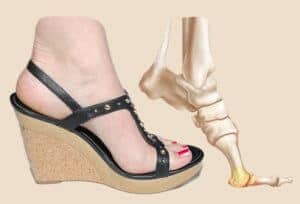Big Toe Pain

Big toe pain can be a result of injury or other medical conditions. These may include arthritis, fractures, and gout. These and other causes such as sesamoiditis, ingrown toenails, and broken toes will require clinical evaluation.
Pain at big toe joint: Everything you need to know
- Causes
- Diagnosis
- Treatment and relief
- Prevention
- Seeing a doctor
- Summary
Activities of daily living and exercise will be very challenging if you have big toe pain.
The metatarsophalangeal (MTP) joint attaches your big toe to your foot. This joint enables the toe to bend up and down. It also propels you forward by being an anchor/push-off point while walking and running.
Conditions that affect the MTP joint explained above can cause pain and swelling around the big toe. This can limit movement at the joint and affect walking patterns and everyday activities.
Gout
When uric acid builds up in a person’s joints, it is called gout. This most commonly occurs in the joint of the big toe. Uric acid is typically excreted in the urine, but may build up and cause crystallization in the joints to occur.
Symptoms
- Inflammation, skin discoloration, swelling, or warmth at the end of the joint
- Intense pain in the middle of the night or early morning
- Shiny skin over affected joint
Treatment
Inflammation that occurs from gout will typically clear in 3-10 days. Treatment options include:
- Drink enough fluids
- Elevation of the feet
- Rest
- Medications to treat inflammation and swelling
Individuals with gout should avoid consuming drinks and foods high in purines. These include alcohol, bacon, liver, and some seafood.
Sesamoiditis
Sesamoid bones are bones that connect tendons or are embedded in the muscle. The kneecap is the largest sesamoid in the body.
Sesamoiditis is the inflammation of the tendons around sesamoid below the big toe. This condition is most commonly seen in runners and dancers.
Symptoms
- Difficulty moving the big toe
- Increases in pain
- Bruising
- Swelling
- Ball of the foot pain
Treatment
Treatment options that your doctor may recommend:
- Steroid injections
- NSAIDs for pain and swelling
- Strapping, padding, or taping of the toes and feet
- Custom orthopedic devices
- Physical Therapy
We’re ready to help.
Schedule an appointment with Beaver Valley Foot Clinic today.
Osteoarthritis at big toe joint:

Osteoarthritis occurs when cartilage wears down at the joints from overuse. When this form of arthritis occurs in the feet, it most commonly affects the MTP joint at the base of your big toe. With time, osteoarthritis in the big toe will cause the cartilage to erode which in turn causes the bones to rub against one another. This frictional force causes pain and inflammation, which can affect walking. Bones spurs can also develop which are bony projections. Bone spurs and osteoarthritis can cause hallux rigidus of the big toe, which is limited movement of the big toe.
Gout
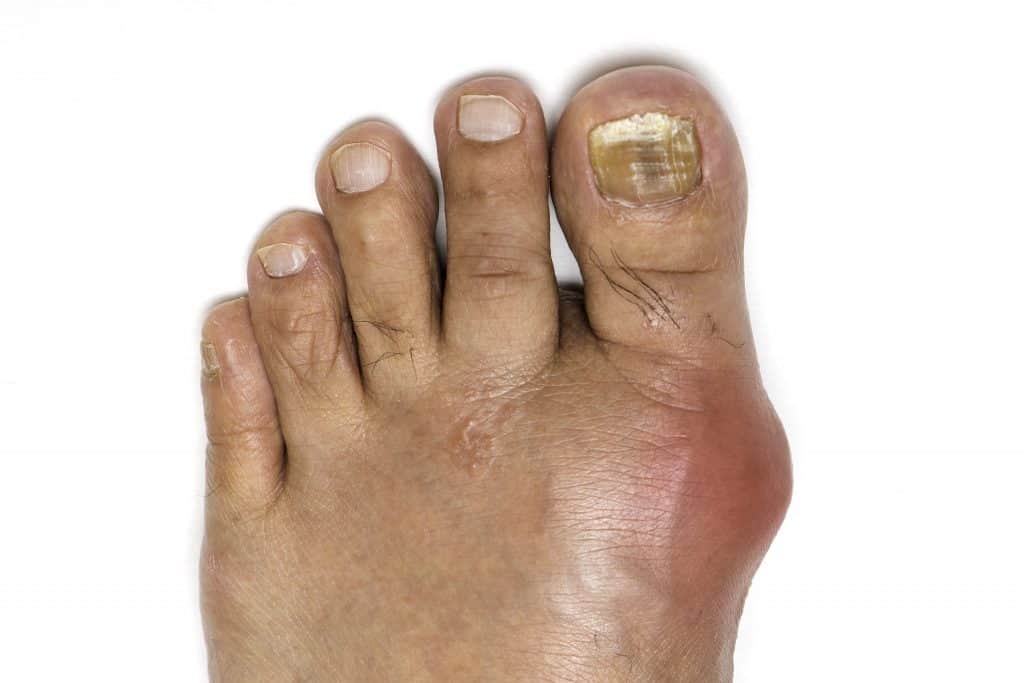
Gout occurs when uric acid crystallizes in the joints and is another type of arthritis. Uric acid is a waste product that passes out of the body in the urine. High levels of uric acid can cause crystallization to occur which is very painful. First symptoms of gout often occur in the big toe, which is accompanied by severe episodes of sharp pain and swelling of the area. Gout may also occur in other parts of the body. Lumps may form over time under the skin in affected regions.
Gout is a common form of arthritis that causes pain, swelling, and joint stiffness. It most commonly affects the big toe joint. Gout incidents can come on quickly and return again over time. Hypertension, cardiovascular, and metabolic disorders are all risk factors for gout to occur. It is most common to see gout in men, but women are more susceptible after menopause.
Facts About Gout
- Gout is caused by excessive uric acid in the bloodstream
- Symptoms are due to crystallization of uric acid in the joints and the physiological response that follows
- Mostly seen in the big toe joint
- Can occur in the middle of the night and be very painful
- Most cases are treatable with medication
How long does it typically take for big toe pain to resolve?
The time it takes for big toe pain to resolve can vary depending on the underlying cause and individual circumstances. Some cases of big toe pain may resolve relatively quickly with conservative treatment, while others may require more time or additional interventions. Here are a few factors that can influence the resolution time:
- Cause of the pain:
The underlying cause of the big toe pain will play a significant role in the recovery timeline. For example, if the pain is due to a minor injury or strain, it may resolve within a few days to weeks with rest, ice, and elevation. On the other hand, conditions such as gout or arthritis may require long-term management and ongoing treatment.
- Timely medical intervention:
Seeking timely medical attention and following appropriate treatment recommendations can help expedite the healing process. Prompt diagnosis and treatment can prevent the condition from worsening or becoming chronic.
- Compliance with treatment plan:
Adhering to the prescribed treatment plan, including medication, physical therapy, or lifestyle modifications, is crucial for optimal recovery. Failure to follow the recommended course of treatment may prolong the resolution time.
- Individual healing factors:
Each person’s body has its own healing capabilities, and factors such as age, overall health, and immune function can influence the recovery time. It’s important to be patient and allow sufficient time for the body to heal.
Can big toe pain affect mobility or quality of life?
Yes, big toe pain can certainly affect mobility and quality of life. The big toe plays a crucial role in walking, balance, and overall foot function. Big toe pain can make walking uncomfortable and difficult. It may cause a limp or alter your gait pattern, affecting your ability to move around freely.
Treatment
Most cases of gout are treated with medication. These medications will treat the symptoms of gout attacks, prevent future flare ups, and reduce the risk of complications such as kidney stones and tophi. These commonly used medications include anti-inflammatory drugs such as NSAIDs, colchicine, and corticosteroids. Inflammation and pain will be reduced by these oral medications. Other medications are used to reduce the uric acid production or improve the ability to remove uric acid. Without treatment, an acute episode of gout will peak between 12-24 hours after being initiated. Individuals can expect a recovery duration of 1-2 weeks without treatment.
Tests and Diagnosis
Gout is not always easy to diagnose because its symptoms are similar to quite a few other conditions. Hyperuricemia commonly occurs in those with gout, but may not be present during a flare up. Also, most people with hyperuricemia do not develop gout.
A diagnostic test that doctors use is the joint fluid test, which extracts fluid from the affected joint via needle. The fluid is reviewed to identify if urate crystals are present. Joint infections can also cause symptoms similar to gout, which allows doctors to look for bacteria when performing the joint fluid test. Fluids may need to be sent to the lab for further examination, which may take a few days.
Blood tests can be used to measure the level of uric acid present in the blood. People may develop symptoms of gout without increased levels of uric acid. Your doctor may also search for urate crystals around joints or within a tophus via ultrasound scan. X-rays do not detect gout, but can rule out other causes.
Broken Toe
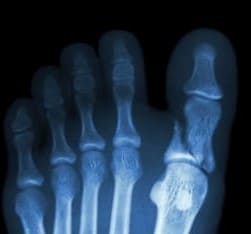
Many injuries of the feet can have an affect on the big toe joint. Stress fractures may result from overuse which causes a small crack to develop from the forces placed on it. We can X-ray on the premises, instantly
Sprains are classified as ligaments in the toe that become torn or stretched. Sports injuries such as turf toe can cause sprains to occur due to excessive pressure on the toe. All the injuries of the toe can cause pain swelling to occur.
Bunion

Bunions are bony lumps that develop along the inner side of the MTP joint. Pain and swelling can occur around the big toe. Stiffness and limited range of motion may also be present. The big toe may start to point toward the second toe, which is known as hallux valgus deformity. Picking shoes and walking are very difficult for someone with this condition. They may occur in anyone, but those who wear tight shoes are at greater risk of developing bunions.
Bunions are deformities of the joint at the base of the big toe. This causes the joint to protrude out and show a visible bump on the side of the foot which is affected. Bunions cause the toe to point in the opposite direction with the potential to overlap onto the toe beside it.
Shoes often put a significant amount of pressure on the protruding joint which may cause a fluid filled sac to form in the joint known as a bursa.
Symptoms
Bunions are commonly known to cause swelling, inflammation, and pain. The big toe may point inward while the joint at the base points outward.
Treatment
To reduce symptoms, a person should look for new shoes that have little to no pressure on the big toe joint. Wide and flexible soles are what to look for.
Other treatment options include the following:
- OTC bunion pads
- NSAIDs or pain medications
- Warm soaks
- Ice
- Massages or manual therapy
Other Causes
- Nail Infections
- Raynaud’s disease
- Morton’s neuroma
- Rheumatoid Arthritis
Sesamoiditis
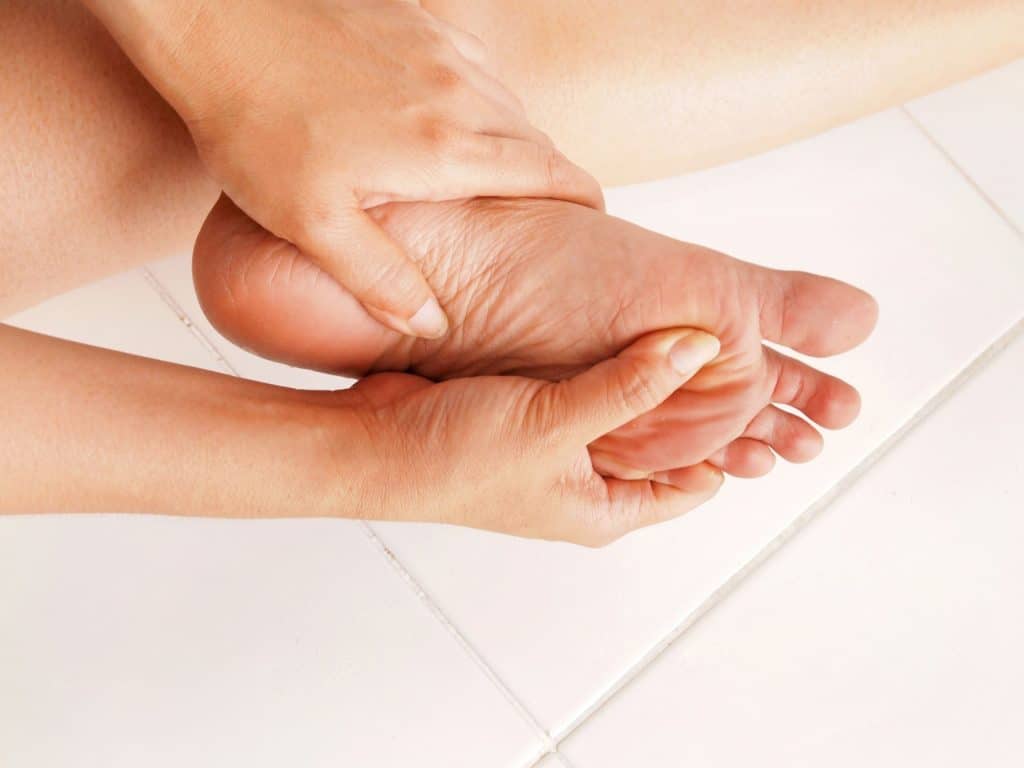
Inflammation of the sesamoid bones and surrounding tendons due to overuse is known as Sesamoiditis. These bones in the foot are beneath the MTP joint, and tendons attach to them to support movement in the area. This condition can cause pain at the base of the big toe and may also lead to swelling, bruising, and limited range of motion.
Diagnosis
Your doctor will perform a physical examination and ask you about your symptoms, lifestyle, and medical history. Range of motion and flexibility may be tested, and the area will be observed for bone spurs and swelling. X-ray may be needed, and further testing such as blood tests may be given to diagnose gout.
Treatment and Relief
Treatment types will vary depending on the cause of big toe pain. Your doctor will likely recommend pain relievers such as NSAIDs. Swelling may be reduced by these medications. In rare cases, your doctor may prescribe corticosteroids. Changes in activity and lifestyle may be recommended as well. Wearing shoes with exra space for your toes is an example of a lifestyle change.
Avoid the activities that caused your injury. Refraining from sports that caused your injury is necessary.Some scenarios may benefit from losing weight to reduce pressure on the toes. Other conditions such as arthritis and gout require specific treatment such as physical therapy. Surgery may be needed in some cases to remove a bunion or repair joint damage.
Prevention
The following tips are recommended to prevent pain at the big toe joint:
- Maintain a healthy weight
- Exercise regularly without excessive strain on the MTP joint
- Avoid wearing tight footwear around the toes
When to see your doctor
Mild pain or pain that gets better over time does not usually require a visit to the doctor. Sprains can typically heal on their own after rest. If the pain doesn’t improve after three days, it may be best to schedule an appointment to see your doctor. If your pain is severe or sudden and unexplained, contact your doctor.
Summary
Pain in the joint of the big toe may be due to trauma, chronic conditions, or pressure built up over time due to activities performed. The underlying cause is usually treatable. Rest, pain medication, and time can heal injuries as well. Conditions such as osteoarthritis will require long-term solutions. Simple lifestyle changes such as wearing appropriate footwear can reduce the risk of toe injuries. Speak to your doctor if your pain does not resolve over time.
Symptoms
Pain while walking or being active are the most common symptoms due to the pressure on the feet and big toes. The following symptoms may also occur:
- Swelling near the big toe joint
- Bump that appears on the top of the joint
- Difficulty moving the big toe
Treatment
The following treatment options for hallux rigidus include surgical and nonsurgical treatments.
Nonsurgical:
- Ice or heat
- Pain medication
- PRP injections
- Changing footwear
Surgical:
- Fusing the joint
- Removal of bone spurs
- Joint replacement or resurfacing
Ingrown Toenail

Ingrown toenails cause pain and discomfort in the big toe. It may occur when a person incorrectly cuts their toenail too short or curves it in too far. Tight shoes may add to the problem and cause extra pain in the case of an ingrown toenail.
Symptoms
- Hardness, swelling, or tenderness of the toe
- Soreness
- Skin discoloration
- Discharge of pus from the area
Treatment
Treatment options begin with nonsurgical methods, but doctors may perform surgery for persistent ingrown toenails. Nonsurgical option include:
- Pain medication such as NSAIDs
- Warm bath soaking 3-4 times daily
- Keeping the feet dry by consistently changing socks
- Comfortable footwear
Surgical options include:
- Partial or full removal of the nail
- Permanent nail removal for chronic cases
Turf toe

Turf toe is an injury that occurs during sporting activities and it is an injury to the joint of the big toe. This injury occurs due to repetitive bending to the big toe or jamming it. Constant jumping or running can cause this to occur. Athletes on artificial turf are more susceptible to this.
Turf toe is identified as pain at the base of the big toe. This is an overuse injury that is commonly caused by a strain. Turf toe may also be a form of sesamoiditis or a sesamoid fracture.
Symptoms
Turf toe is most commonly caused by repetitive movements. Pain and swelling will increase over. Loss of mobility and swelling in the joint may also occur.
Treatment
Avoiding the physical activity or movements that are irritating the region is the best option for treatment. Treatment also should be accompanied by rest, ice, compression, and elevation (RICE). Your doctor may want you to wear less flexible shoes when participating in physical activities. Surgery is typically the last resort to treatment but may be recommended.

Toe fractures
Toe fractures can occur in any bones of the toes. Minor fractures may only need rest, ice, and pain medication. More severe fractures may need surgical procedure. Consult your physician if you suspect a fracture.
Toe sprains
Toe sprains may occur when you jam or stub your toes, which damages the tendon or soft tissues. If a fracture is absent, the pain and swelling should go away within a few days.
Hallux rigidus
Hallux rigidus, also known as “stiff big toe,” is a form of arthritis at the base of the big toe. Pain and stiffness of the joint may worsen over time. Treatment involves pain relievers and PT exercises. Surgery may be required in some cases.
Corns
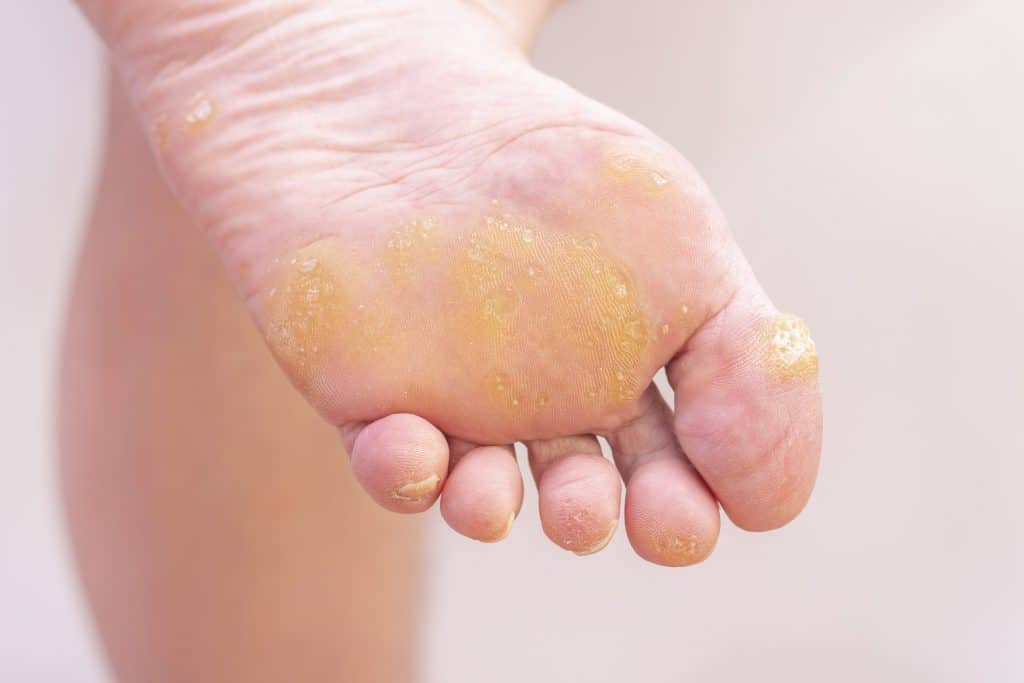
Corns are thick buildups of tough skin on a point of irritation or pressure on the feet or toes. They sometimes have a horn-like appearance. Calluses are wider areas of tough skin that build up as a result of irritation or pressure. Both are most commonly caused by improper footwear.
To treat them:
- Wear better-fitting shoes
- Soak the foot and use a pumice stone to wear down the extra skin
Sesamoid fracture
Sesamoid fracture is a break of the small bones that are embedded in tendons attached to the big toe. Pain in and around the big toe is the main symptom of this form of fracture. .
To treat Sesamoid fracture:
- Rest, ice, and elevate your foot.
- Wear stiff-soled shoes or foot pads to relieve pressure.
- Take pain relievers.
If you’re still in pain, talk to your Podiatrist.
Summary
Injuries or minor medical conditions often cause most cases of big toe pain. Often, the cause is easy to treat and fully curable. Individuals with big toe pain should refrain from activities which cause pain to be regenerated. Follow your treatment plan from your doctor.
Diagnosis of sesamoiditis
Questions that your doctor may ask you when diagnosing sesamoiditis:
- What activities do you perform regularly?
- When and how did the pain start?
- What activities cause the pain or make it better?
- What medications have you tried and have they helped?
Your doctor will also visually examine the toes and ask you to move it in different directions. An X-ray may also be needed to examine the foot and toe to identify if fractures are present. An MRI or bone scan may be needed in some cases to identify damage to the bones. Sesamoid bones may vary in appearance, which can be challenging to identify if fractures are present.
Can Terrible Posture Or Walking Habits Lead To Pain In Big Toe?
Yes, if you have a terrible posture or walking habits then it can definitely lead to pain in the big toe, here’s how:
1. Pressure On The Toe Joint: If you have an abnormal gait, or poor posture then it can place extra pressure on certain areas on your feet, this can include your big toe! As you continue to have an abnormal gait, the pressure will keep increasing which can lead to pain in big too, which has chances to develop conditions like bunions Or stiff big toe.
2. Uneven Weight Distribution: A bad posture or gait leads to imbalance of body weight, which means one side of the body might be managing more weight than the other, maybe this is the reason a lot of weight is being put on your big toe, which leads to joint strain, pain and even injuries over time.
3. Toe Griping: If your posture or walking habits cause you to grip the ground with you’re your toe, then it will put a lot of strain on it which will lead to pain. This can usually happen during activities like walking or running, so be careful.
When To See A Doctor For My Big Toe Pain?
Seeing the doctor can be best option if you experience these symptoms:
1. Constant Pain: If the pain persists for more than a few days and doesn’t improve with home remedies like rest, Ice, heat or over-the-counter relievers then you should go!
2. Swelling and Redness: Swelling, redness or warmth when touch are signs of infection, these mustn’t be ignored at all as it can be serious.
3. Limited Mobility: If you are unable to move your toe or having difficulty while walking then, this simple pain may turn into much bigger problems, so get to the doctor as soon as possible.
Treatment of sesamoiditis
In many cases, sesamoiditis can be treated at home. Treatment options include the following:
- Stop activities that cause pain
- Pain medication
- Ice
- Wear comfortable shoes
- Avoid high heels
- Cushioned insole for support
Your doctor may recommend taping the big toe in a slightly bent position to stretch and reduce pressure onto the other toes. This position is known as plantar flexion. Corticosteroid injections may be given by your doctor to reduce inflammation. In some cases, a leg fracture brace will be recommended to reduce pain and pressure. Up to six weeks or more can be needed to relieve the pain of sesamoiditis. If pain or symptoms continue or become worse, a stress fracture may be present. In rare cases of sesamoiditis, surgery may be recommended.
Prevention of sesamoiditis
Comfortable footwear and support to your feet can aid in the prevention of sesamoiditis. Most shoes need to be replaced every six months if you are highly active. Supportive insoles or a special pad known as a metatarsal bar are used for additional support.
Sesamoiditis can occur due to overpronation, when the foot rolls slightly inward during walking patterns. To correct this, people can benefit from a training specialist to correct running and walking patterns. This will aid in reducing pressure on the feet. Shorter strides can prevent this overpronation. This is called a midfoot strike in a running stride. Custom-designed orthotics can be prescribed to reduce the incidence of overpronation. When symptoms improve for sesamoiditis it is important to change activity patterns to reduce the risk of it occurring again.

